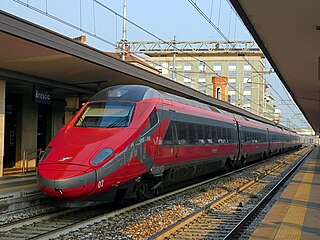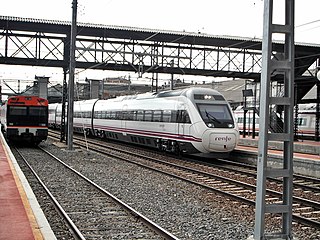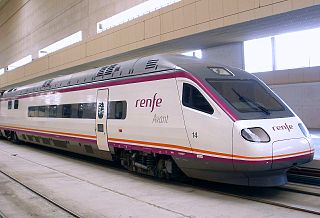
Transport in Spain is characterised by a network of roads, railways, trams, air routes, and ports. Its geographic location makes it an important link between Europe, Africa, and the Americas. Major forms of transit generally radiate from the capital, Madrid, located in the centre of the country, to link with the capitals of the autonomous communities.

Renfe, officially Renfe-Operadora, is Spain's national state-owned railway company.

Rail transport in Spain operates on four rail gauges and services are operated by a variety of private and public operators. The total route length in 2012 was 16,026 km.

Pendolino is an Italian family of high-speed tilting trains used in Italy, Spain, Germany, Poland, Portugal, Slovenia, Finland, the Czech Republic, Slovakia, the UK, the US, Switzerland, China, and Greece. It was also used in Russia from December 12, 2010 until March 26, 2022. Based on the design of the Italian ETR 401, it was further developed and manufactured by Fiat Ferroviaria, which was taken over by Alstom in 2000.

Talgo is a Spanish manufacturer of intercity, standard, and high-speed passenger trains. Talgo is an abbreviation of Tren Articulado Ligero Goicoechea Oriol

Cercanías Madrid is the commuter rail service that serves Madrid, the capital of Spain, and its metropolitan area. It is operated by Cercanías Renfe, the commuter rail division of Renfe, the former monopoly of rail services in Spain. Its total length is 370 km.
High-speed railways in Spain are in operation since 1992 when the first line was opened connecting the cities of Madrid, Córdoba and Seville. Unlike the rest of the Iberian broad gauge network, the Spanish High-speed network mainly uses standard gauge. This permits direct connections to outside Spain through the link to the French network at the Perthus Tunnel. High-speed trains run on a network of high-speed rail track owned and managed by ADIF, where the dominant service is AVE while other high speed services such as Avant, Alvia, Avlo, Euromed, Ouigo España and Iryo, as well as mid-speed (Altaria) services also operate.
Euromed is a high-speed rail service operated by Renfe along the Spanish Mediterranean coast.

The Madrid–Barcelona high-speed rail line is a 621-kilometre (385.9 mi) standard gauge railway line inaugurated on 20 February 2008. Designed for speeds of 350 km/h (217.5 mph) and compatibility with neighbouring countries' rail systems, it connects the cities of Madrid and Barcelona in 2 hours 30 minutes. In Barcelona the line is connected with the Perpignan–Barcelona high-speed rail line leading into France which connects it to the European high speed network.

The Renfe Class 100 is a high-speed train used for AVE services by the Renfe Operadora, in Spain. It was the first high-speed train put into service in Spain, in 1992.

The Renfe Class 102 or S-102 is a high-speed train used for the AVE service and operated in Spain by the state-run railway company Renfe, and based on Bombardier Transportation's power car technology. Outside AVE service, Talgo markets this train as the Talgo 350.

The Renfe Class 103 is a high-speed train used for the AVE service and operated in Spain by the state-run railway company RENFE. The trainset is also known as S103 or S/103.

The Renfe Series 333 are high power six-axle diesel-electric locomotives built in the 1970s; at the time of their introduction they were the most powerful non-electric locomotives in Spain.

The Renfe Class 354 was a series of eight diesel hydraulic locomotives manufactured by Krauss-Maffei in Germany specifically to pull Talgo pendular coaches which were introduced shortly before the acquisition of these machines.

Rail transport in Catalonia operates on three rail gauges and services are operated by a variety of public operators:
Alvia is a high-speed train service in Spain offered by Renfe Operadora on long-distance routes with a top speed of 250 km/h (160 mph). The trains have the ability to use both Iberian gauge and standard gauge, which allows them to travel on the recently constructed high-speed lines for part of the journey before switching to the "classic" Iberian gauge network to complete it. Trains that run exclusively on high-speed tracks are branded AVE or Avant.

The Renfe Class 120 are electric multiple units used on Alvia high-speed rail services in Spain.

The Renfe Class 252 are a series of Bo'Bo' electric locomotives, built by CAF, Meinfesa, Siemens and Krauss-Maffei for RENFE. 15 units were built for the AVE Madrid–Seville high speed line in, and 60 units constructed for general use to Iberian gauge (1668mm).

Oaris is a modular high-speed train platform developed by the Spanish manufacturer CAF.

Avant is a high-speed, medium-distance passenger transport rail service, operated in Spain by the Spanish public company Renfe. Avant services circulate at a maximum speed of 250 km/h, compared to the 300 km/h maximum speed of the AVE service. Their routes usually cover different provinces within the same autonomous community or between neighboring ones. Regional services at conventional speed are called Renfe Media Distancia.
















